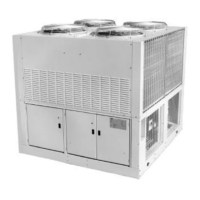10 IOMM ACZ/AGZ-1
Glycol Solutions
The use of a glycol/water mixture in the CDE evaporator to prevent freezing will reduce system
capacity and efficiency and increase pressure drop. The system capacity, required glycol solution flow
rate, and pressure drop with glycol may be calculated using the following formulas and Table 4 and
Table 5.
1. Capacity – Multiply the capacity based on water by the Capacity correction factor from or Table
4 and Table 5 to
2. Flow – Multiply the water evaporator flow by the Flow correction factor from and Table 4 or Table
5 determine the increased evaporator flow due to glycol
If the flow is unknown, it can be calculated from the following equation:
FactorCorrectionFlow
TDelta
glycolCapacityTons
(gpm) Flow Glycol ×
−
×
=
)(24
For Metric Applications – Use the following equation for metric applications:
FactorCorrectionFlow
TDelta
CapacitykW
×
−×
=
18.4
(l/s) Flow Glycol
3. Pressure drop -- Multiply the water pressure drop from Figure 7 by Pressure Drop correction
factor from Table 4 or Table 5 to obtain corrected glycol pressure drop. High concentrations of
propylene glycol at low temperatures may cause unacceptably high pressure drops.
4. Power -- Multiply the water system power by Power correction factor from Table 4 or Table 5.
Test coolant with a clean, accurate glycol solution hydrometer (similar to that found in service
stations) to determine the freezing point. Obtain percent glycol from the freezing point table below. It
is recommended that a minimum of 25% solution by weight be used for protection against corrosion.
CAUTION
Do not use an automotive grade antifreeze. Industrial grade glycols must be used.
Automotive antifreeze contains inhibitors which will cause plating on the copper tubes within
the chiller evaporator. The type and handling of glycol used must be consistent with local
codes.
Table 4, Ethylene Glycol Correction Factors
Freeze Point%
E.G.
°F °C
Capacity Power Flow Pressure Drop
10 26 -3 0.991 0.996 1.013 1.070
20 18 -8 0.982 0.992 1.040 1.129
30 7 -14 0.972 0.986 1.074 1.181
40 -7 -22 0.961 0.976 1.121 1.263
50 -28 -33 0.946 0.966 1.178 1.308
Table 5, Propylene Glycol Correction Factors
Freeze Point%
P.G.
°F °C
Capacity Power Flow Pressure Drop
10 26 -3 0.987 0.992 1.010 1.068
20 19 -7 0.975 0.985 1.028 1.147
30 9 -13 0.962 0.978 1.050 1.248
40 -5 -21 0.946 0.971 1.078 1.366
50 -27 -33 0.929 0.965 1.116 1.481
Note: The procedure
does not specify the
type of glycol. Use
the derate factors
found in Table 4 for
corrections when
using ethylene glycol
and those in Table 5
for propylene glycol.

